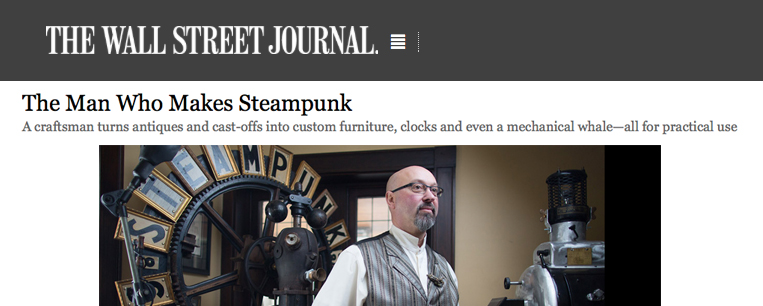

Bruce Rosenbaum likes to turn old objects into useful things. That is how he started steampunking before he knew what it was.
The term “steampunk” tends to conjure up images of bookish adults in Victorian costumes, daydreaming about time travel and quoting Jules Verne. But for some, the science-fiction subculture is less about histrionics and more about history.
“In its purest form, it’s history, plus art, plus technology,” Mr. Rosenbaum says. “But function is key. Real steampunk art includes purposeful mechanics, not just random doodads. It has to perform.”
Mr. Rosenbaum, 51 years old, and his wife Melanie, 55, own a design company in Sharon, Mass., called ModVic that repurposes salvaged, often antique, furniture into functioning, modern pieces: a desk fashioned out of an old bandsaw, an iPod dock that resembles a phonograph. The company name is a combination of “modern” and “Victorian”—the essence of steampunk design.
They complete about 100 pieces every year that range in price from $5,000 to $250,000, sometimes more. Among some of the most bizarre pieces Mr. Rosenbaum has created are a back tattoo machine for the TV show “New York Ink,” and a Tom Sawyer paint jetpack for the Mark Twain Museum in Hartford, Conn. The museum enlisted ModVic to participate in an art show based on questioning what it would have looked like if Mark Twain had modern technology.
Recently, he completed a 6-foot mechanical whale for a hotel in Nantucket, Mass. Its activation button is housed in an old ship compass and, keeping utility in mind, a hidden security camera is tucked into the whale’s mouth. Mr. Rosenbaum’s voice rises with excitement when he talks about the project. “It caused a stir when we installed it because it’s a little James Bond,” he says. “But now, it’s the hit of the island.”
For materials, Mr. Rosenbaum combs East Coast thrift shops and art auctions. “You know how some men’s watches expose all the inner gadgets? That’s my whole house,” he says.
ModVic’s typical clients are history lovers who pine for the craftsmanship and detail of a bygone era. They’re mostly men, Mr. Rosenbaum says. Leather, copper, iron and bronze are steampunk staples, as are nods to mechanics. Mr. Rosenbaum employs four people to handle the manufacturing at his home studio and works with about 50 local artists who specialize in elements such as ironwork and carpentry. He estimates about 70% of his business is commissioned works. Some clients come with a specific idea, he said, while others are open to experimenting.
John Lanza, a patent attorney in Boston, commissioned a ModVic desk for his office that incorporated a couple family heirlooms, including an old bandsaw that belonged to his dad. It cost about $10,000. Before long, they added a credenza and storage shelving to the space. Next up is a music player. By the time that is finished, Mr. Lanza will have invested about $40,000 in steampunking the room.
“It’s partly about quality—that desk probably weighs 1,000 pounds—but it’s more about personality,” said Mr. Lanza, who met Mr. Rosenbaum at a steampunk fair in Waltham, Mass., in 2011. “People walk by my office everyday and stop dead in their tracks.”
Gary Sullivan hired Mr. Rosenbaum to build a grandfather clock made from an 1880s clock case he found at an auction in Bellingham, Mass. Mr. Sullivan is an antiques dealer who specializes in early American grandfather clocks and appraises them for public television’s “Antiques Roadshow.”
The 7-foot-tall piece, which includes pieces of Victorian lanterns and a time capsule, took about eight months to build and cost $30,000.
Mr. Sullivan says the art of steampunking has grown tremendously in the past five years. He credits it partly to an exhaustion with modern objects that have built-in obsolescence and partly to an increased interest in authentic décor customized to personal tastes.
“It’s my alter ego,” he says of his interest. “In my business, I deal with very wealthy clients with sophisticated tastes. My steampunk side is quirkier, looser, a little less serious—a lot less serious.”
Mr. Sullivan, like Mr. Rosenbaum, is a only moderate fan of science fiction. He once made a top hat with moving gears and a lid that puffs steam. (There is a video of it on YouTube.) He was drawn to steampunk, he says, for its sculpture art.
Mr. Rosenbaum credits growing up in Marblehead, Mass., for his appreciation of history. The harbor town north of Boston was established by Pilgrims who arrived on the Mayflower.
In the 1990s, he and his wife started a direct-mail marketing business targeting consumers based on major life events. (If you buy a home and then receive cable coupons in the mail, it’s likely the Rosenbaums.)
After a few years, Mr. Rosenbaum set up a workshop to explore his artistic interests. The first piece he made was a mission-style coat rack festooned with Victorian hardware and topped with a World War II clock. He had never heard of “steampunking,” he says.
In 2007, ModVic was born. It began as a Victorian-home restoration company. The couple completed only one project before the financial collapse. They relaunched the business, focusing on period furniture, such as clocks or arm chairs.
At the same time, they were restoring their own home, which was beginning to generate buzz for its quirky décor. Today, it’s a steampunk showcase and ModVic’s most effective advertisement.
Write to Megan Buerger at megan.buerger@wsj.com
